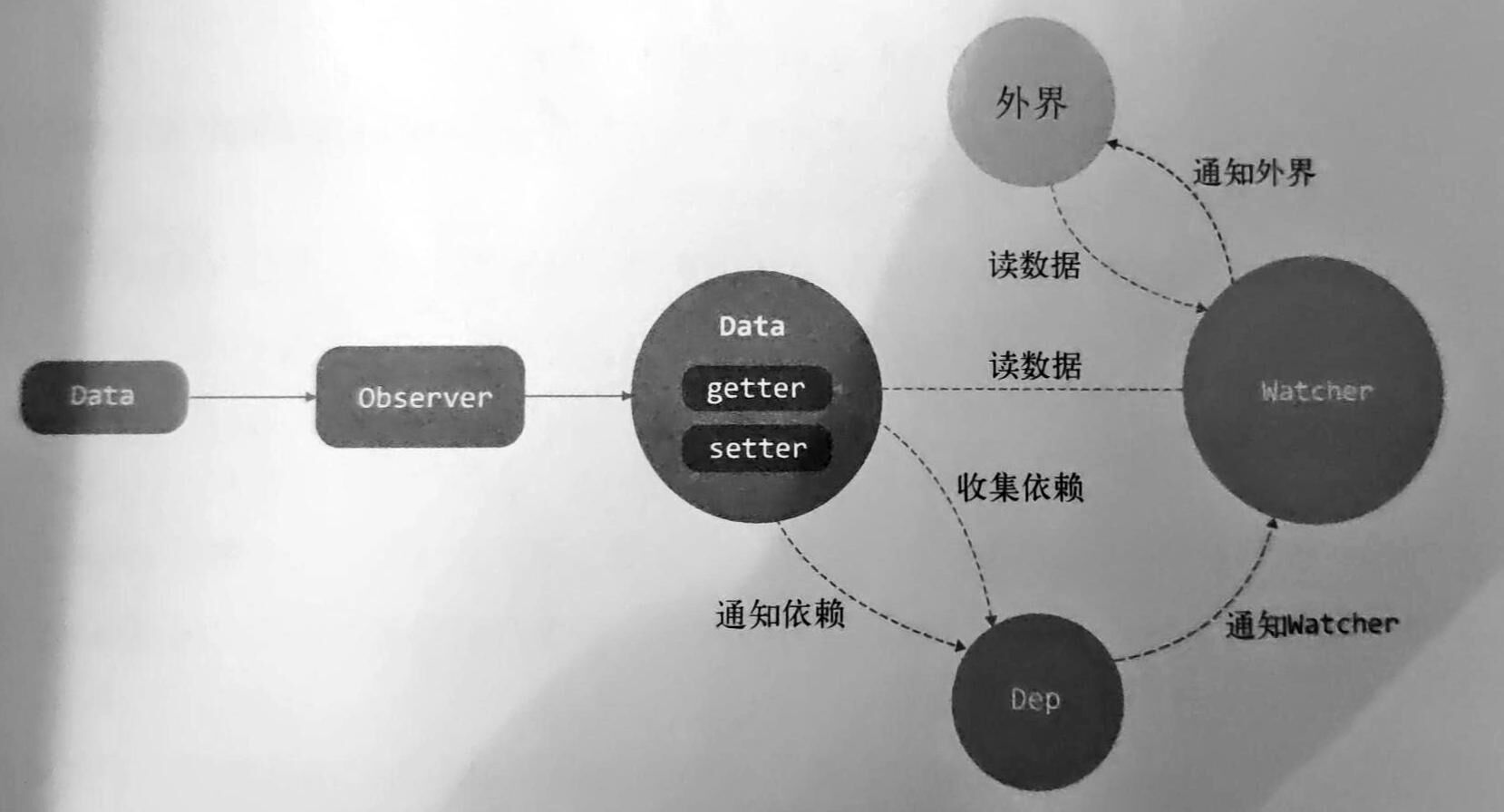变化侦测
Object 侦测

递归侦测所有key
1
2
3
4
5
6
7
8
9
10
11
12
13
14
15
16
17
18
19
20
21
22
23
24
25
26
27
28
29
30
31
32
33
34
35
36
37
38
39
40
41
42
43
44
45
46
47
48
49
50
51
52
53
54
55
56
57
58
59
60
61
62
63
64
65
66
67
68
69
70
71
72
73
74
75
76
77
78
79
80
81
82
83
84
85
86
87
88
89
90
91
92
93
94
95
96
97
98
99
100
|
export class Observer {
constructor (value) {
this.value = value
if(!Array.isArray(value)) {
this.walk(value)
}
}
walk(obj) {
const keys = Object.keys(obj)
for (let i = 0; i < key.length; i++) {
defineReactive(obj, keys[i], obj[keys[i]])
}
}
}
function defineReactive(data, key, val) {
if (typeof val === 'object') {
new Observer(val)
}
let dep = new Dep()
Object.defineProperty(data, key, {
enumerable: true,
configurable: true,
get: function () {
dep.depend()
return val
},
set: function (newVal) {
if(val === newVal) {
return
}
val = newVal
dep.notify()
}
})
}
export default class Dep {
constructor () {
this.subs = []
}
addSub (sub) {
this.subs.push(sub)
}
removeSub (sub) {
remove(this.subs, sub)
}
depend () {
if (window.target) {
this.addSub(window.target)
}
}
notify () {
const subs = this.subs.slice()
for (let i = 0, l = subs.length; i < l; i++) {
subs[i].update()
}
}
}
function remove (arr, item) {
if (arr.length) {
const index = arr.indexOf(item)
if(index > -1) {
return arr.splice(index, 1)
}
}
}
export default class Watcher {
constructor (vm, expOrFn, cb) {
this.vm = vm
this.getter = parsePath(expOrFn)
this.cb = cb
this.value = this.get()
}
get() {
window.target = this
let value = this.getter.call(this.vm, this.vm)
window.target = undefined
return value
}
update() {
const oldValue = this.value
this.value = this.get()
this.cb.call(this.vm, this.value, oldValue)
}
}
|
Array 侦测
Array追踪变化的方式和Object不一样.因为它是通过方法改变内容的,所以我们通过创建拦截器去覆盖数组原型的方式来追踪变化.
为了不污染全局Array.prototype,我们在Observer中只针对那些需要侦测变化的数组使用_proto_来覆盖原型方法,但ES6之前并不是标准属性,针对不支持的游览器,直接循环拦截器,把拦截器中的方法直接设置到数组身上拦截Array.prototype上的原生方法.
Array收集依赖的方式和Object一样,都是在getter中收集.但是由于使用依赖的位置不同,数组要在拦截器中向依赖发送消息,所以依赖不能像Object那样保存在defineReactive中,而是把依赖保存在了Observer实例上.
在Observer中,对每个侦测了变化的数据都标上印记_ob_,并把this(Observer实力)保存在_ob_上.主要有两个作用,一方面是为了标记数据是否被侦测到,另一方面可以很方便的通过数据取到_ob_,从而拿到Observer实例上保存的依赖.当拦截到数组发生到变化时,向依赖发送通知.
除侦测数组的自身变化外,数组中元素发生的变化也要侦测.我们在Observer中判断如果当前被侦测的数据是数组,则调用observeArray方法将数组中的每一个元素都转换成响应式并侦测变化.
当用户使用push等方法像数组中新增数据时,新增的数据也要进行变化侦测.如果是push,unshift,splice方法,从参数中将新增数据提取出来,然后使用observeArray对新增数据进行变化侦测.
1
2
3
4
5
6
7
8
9
10
11
12
13
14
15
16
17
18
19
20
21
22
23
24
25
26
27
28
29
30
31
32
33
34
35
36
37
38
39
40
41
42
43
44
45
46
47
48
49
50
51
52
53
54
55
56
57
58
59
60
61
62
63
64
65
66
67
68
69
70
71
72
73
74
75
76
77
78
79
80
81
82
83
84
85
86
87
88
89
90
91
92
93
94
95
96
97
98
99
100
101
102
103
104
105
106
107
108
109
110
111
112
113
114
115
116
117
118
119
120
121
122
123
124
125
126
127
128
129
130
131
132
133
134
135
136
137
138
139
140
141
142
143
144
145
146
147
148
149
|
const arrayProto = Array.prototype
export const arrayMethods = Object.create(arrayProto)
;[
'push',
'pop',
'shift',
'unshift',
'splice',
'sort',
'reverse'
].forEach(function (method) {
const original = arrayProto[method]
def(arrayMethods, method, function mutator (...args) {
const result = original.apply(this, args)
const ob = this.__ob__
let inserted
switch (method) {
case 'push':
case 'unshift':
inserted = args
break
case 'splice':
inserted = args.slice(2)
break
}
if (inserted) ob.observeArray(inserted)
ob.dep.notify()
return result
})
})
import { arrayMethods } from './array'
const hasProto = '__proto__' in {}
const arrayKeys = Object.getOwnPropertyNames(arrayMethods)
function def (obj, key, enumerable) {
Object.defineProperty(obj, key, {
value: val,
enumerable: !!enumerable,
writable: true,
configurable: true
})
}
export class Observer {
constructor (value) {
this.value = value
this.dep = new Dep()
def(value, '__ob__', this)
if(Array.isArray(value)) {
this.observeArray(value)
} else {
this.walk(value)
}
}
observeArray (items) {
for (let i =0, l = items.length; i < l; i++) {
const augment = hasProto ? protoAugment : copyAugment
augment(value, arrayMethods, arrayKeys)
}
}
}
function protoAugment (target, src, keys) {
target.__proto__ = src
}
function copyAugment (target, src, keys) {
for (let i = 0, l=keys.length; i < l; i++) {
const key = keys[i]
def(target, key, src[key])
}
}
function defineReactive (data, key, val) {
let childOb = observe(val)
let dep = new Dep()
Object.defineProperty(data, key, {
enumerable: true,
configurable: true,
get: function () {
dep.depend()
if (childOb) {
childOb.dep.depend()
}
return val
},
set: function (newVal) {
if(val === newVal) {
return
}
dep.notify()
val = newVal
}
})
}
export function observe (value, asRootData) {
if (!isObject(value)) {
return
}
let ob
if (hasOwn(value, '__ob__') && value.__ob__ instanceof Observer) {
ob = value.__ob__
} else {
ob = new Observer(value)
}
return ob
}
|
vm.$watch
vm.$set
vm.$delete
